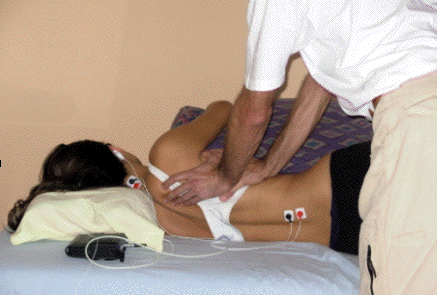- INTRODUCTION: The physiological
mechanisms influenced or activated by manual
therapies are poorly understood and consequently
most approaches lack objectivity both in
diagnosis and treatment. However, a myofascial
release technique called Muscle Repositioning
("MR") appears to evoke specific and detectable
mechanical and neural reactions. A previously
published study sets forth the recorded increase
in tonic activity of the cervical erectors
during MR maneuvers in the occipital region
[1]. This study investigated possible
increases in tonic muscular activity during an
MR maneuver in the thoracic region.
-
- METHODS: Fourteen healthy adults aged
34.21±10.24 yrs had their right cervical
and lumbar erectors monitored by surface
electromyography. (Nexus 10, Mind Media B.V.,
Netherlands). From a side-lying position, each
subject received two MR maneuvers administered
to the right side of the thorax from an
experienced practitioner (fig). The maneuvers
delivered a particular set of forces, which
characteristically produce a visually evident
integration of body segments, causing them to
appear unified as a single block when manually
vibrated (see videos at
www.musclerepositioning.blogspot.com). Each
maneuver continued until the practitioner felt a
tissue release (a tactually perceptible sliding
of internal soft parts relative to one another).
The duration of the maneuvers were
registered.
-
- RESULTS: The first maneuver lasted
14.75±5.22 min, and the second
7.63±3.35 min. Thirteen subjects showed
increased cervical erector activity, 11 during
both maneuvers and 2 during only the second
maneuver. Such activity was more pronounced and
ensued more quickly during the second maneuver.
Seven subjects also showed increased lumbar
activity, which in six of them was synchronous
with the increased cervical activity.
Characteristically, the muscular reactions
became progressively stronger, as did the degree
of apparent segmental integration. Both the
muscular reactions and the segmental integration
often peaked at or near the conclusion of the
maneuver -i.e., upon tissue release - and
dropped thereafter.
-
 -
- DISCUSSION:
- Manually induced tonic
reactions
- These observations support the possibility
that specific and sustained manual input can
systematically evoke tonic reflexes; which
synchronicity between lumbar and cervical
reactions show their systemic feature. The
greater responsiveness of the cervical region,
as compared to the lumbar segment, may be
related to a richer proprioceptive innervation
of the former. The smaller latency and larger
EMG responses in the second maneuver suggest
that the first one should have enhanced the
sensitivity of the circuits involved to a lower
threshold. It is believed that the manual forces
applied tense the fascial system, stimulating
afferences that produce such reflexes, which
seem to further tense the fascias, evoking an
even stronger muscle reaction, in a positive
feedback loop, which advances up to the point of
tissue release. The physiologic significance of
these recorded phenomena remains unknown, but
taken together with observations from MR
clinical practice, they are reminiscent of
pandiculation.
-
- Pandiculation-like
reflexes?
- Pandiculation, which includes yawning, is
the instinctual soft tissue stretching almost
ubiquitous in animals, believed to underlie
neuromusculoskeletal development and maintenance
[2]. During pandiculation, a progressive
and involuntary tonic activity gradually unites
bodily segments in a block, up to an acme, when
soft tissues are vigorously stretched
(pandiculare in latin means stretch). Curiously,
a similar progressive involuntary tonic action,
up to an acme (tissue release, in this case) is
observed during MR maneuvers, suggesting a
connection between these phenomena. Moreover,
the subjective experiences of the subjects were
reported as being similar to
pandiculation.
-
- A reflex-based myofascial release
technique?
- Taken together, these facts suggest that MR
may be considered a blend of myofascial release
with a sort of "assisted pandiculation".
Therefore, the forces available for tissue
release may be the sum of the therapist's manual
input with the client's self-generated forces of
the tonic pandiculation-like reflexes. Such
feature could account for a high level of
clinical efficacy in the treatment of
musculoskeletal disorders. If so, as the
outcomes of MR clinical practice also suggest,
MR would have therapeutic utility. Moreover, the
ability to monitor physiological responses in
real time may bring objectivity to MR and
possibly also to other manual techniques.
-
- Martial arts, yoga and pandiculation:
further reflections about health
maintenance
- During MR practice, bodily segments manually
united into a block produce a characteristic and
palpable firmness of the client's body. Both
aspects (linking of body segments and firmness)
resemble features cultivated in some Eastern
disciplines, as in styles of Chi-Kun and Yoga.
Moreover, similarly to pandiculation, they are
believed to stimulate physiological
self-maintenance mechanisms, besides advocating
specific attentional states that evoke
spontaneous motor expressions. Taken together,
these facts suggest connections among Eastern
disciplines, MR and pandiculation. The latter,
still poorly understood in its physiological
significance, may be an overlooked mechanism in
health maintenance.
-
-
- 1.Bertolucci, L F: Muscle Repositioning: "A
new verifiable approach to neuro-myofascial
release?" Journal of Bodywork and Movement
Therapies, 12: 213&endash;224, 2008.
-
- 2.Walusinski,
O: Yawning: Unsuspected avenue for a better
understanding of arousal and interoception. Med
Hypotheses, 67: 6-14, 2006.
|


